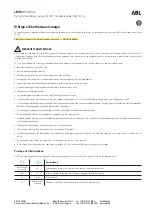
•
Check for accumulations of plants or brush. These
things could be a fire hazard. They might hide dam-
age to fuel lines, brake hoses, axle pinion seals, and
propeller shafts.
•
After extended operation in mud, sand, water, or
similar dirty conditions, have the radiator, fan, brake
rotors, wheels, brake linings, and axle yokes
inspected and cleaned as soon as possible.
WARNING!
Abrasive material in any part of the brakes may cause
excessive wear or unpredictable braking. You might
not have full braking power when you need it to pre-
vent a collision. If you have been operating your
vehicle in dirty conditions, get your brakes checked
and cleaned as necessary.
•
If you experience unusual vibration after driving in
mud, slush or similar conditions, check the wheels
for impacted material. Impacted material can cause
a wheel imbalance and freeing the wheels of it will
correct the situation.
LIMITED-SLIP DIFFERENTIAL
The limited-slip differential provides additional traction
on snow, ice, mud, sand and gravel, particularly when
there is a difference between the traction characteris-
tics of the surface under the right and left rear wheels.
During normal driving and cornering, the limited-slip
unit performs similarly to a conventional differential. On
slippery surfaces, however, the differential delivers
more of the driving effort to the rear wheel having the
better traction.
The limited-slip differential is especially helpful during
slippery driving conditions. With both rear wheels on a
slippery surface, a slight application of the accelerator
will supply maximum traction. When starting with only
one rear wheel on an excessively slippery surface,
slight momentary application of the parking brake may
be necessary to gain maximum traction.
WARNING!
On vehicles equipped with a limited-slip differential
never run the engine with one rear wheel off the
ground since the vehicle may drive through the rear
wheel remaining on the ground. You could lose con-
trol of the vehicle.
Care should be taken to avoid sudden accelerations
when both rear wheels are on a slippery surface. This
could cause both rear wheels to spin, and allow the
vehicle to slide sideways on the crowned surface of a
road or in a turn.
WINCH USAGE — POWER WAGON ONLY
(IF EQUIPPED)
THINGS TO KNOW BEFORE USING
YOUR WINCH
General Winch Information
Your vehicle is equipped with an electric vehicle recov-
ery winch. This winch uses the electrical power from the
vehicle charging system to power a motor that winds
the winch rope onto the winch drum via planetary gear
reduction. By nature, a winch is capable of generating
very high forces and should be used with care. Do not
operate the winch without reading and understanding
the complete winch owner's manual.
Tensioning The Winch Rope
The winch rope must be properly tensioned before use.
Follow the instructions below to tension the rope:
1. Un-spool the rope leaving five wraps of rope on the
winch drum.
2. Attach the hook to a suitable anchor point.
CAUTION!
Be certain the anchor will withstand the load required
to tension the winch rope.
3. Apply at least 1,000 lb (454 kg) of tension to the
rope while winding the rope. Always use care to
ensure the rope does not pile up on one side of the
drum and is neatly wound onto the drum.
CAUTION!
The winch rope must spool on the winch drum in the
direction indicated on the drum rotation decal on the
winch.
198
STARTING AND OPERATING
















































